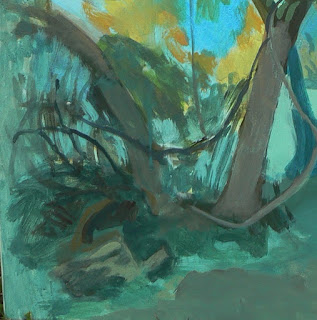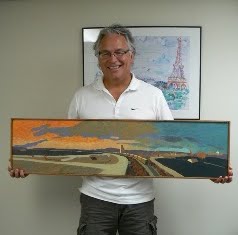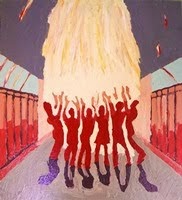From the back of my pickup I pulled a factory-sealed canvas measuring 30 by 40 inches. After opening and disposing the wrapping I edged the sides with blue painter's tape. Though the view was wide and horizontal I chose a vertical format.
The foliage from either side of the basin dipped down in a great U-shape at my feet and was completely in shadow when I first got there. I wanted to keep that in the painting. My focal point was the silhouette of a lone bush in the lower center of the U-shape.
Twenty minutes. Double click on image to see enlarged.
With lots of sunshine, the temp climbed to 46 degrees. Soon I worked on the sky and the light orange above the horizon. I pushed the west and southern banks back into the distance. I wanted a large body of water with the hint of trees. Lord willing, this piece would draw me back to the area.
.
Forty minutes.
There was traffic on the rural highway, the sound of passing trains, and a number of pickups kicked up dust, coming and going on the gravel road. One pulled along side and two men walked over to view the activity. Was the back-lit shadow on the canvas a distraction for me? No, I replied. I paid no attention to it. What about the dead limbs in the water and the tall broadcast antenna on the far shore? Was I going to include them in the painting? I wanted to keep the design simple, I explained. Something to help build my confidence. Then I showed him a pond study,next.
In which I ignored
 the young saplings standing in the water and did not paint them-- to see what the painting would look like that way. The surface of that pond was covered green with duckweed. I imagined it blue, then painted it blue, just to see what it would look like. And both of those decisions transformed how I saw my source material. For the better.
the young saplings standing in the water and did not paint them-- to see what the painting would look like that way. The surface of that pond was covered green with duckweed. I imagined it blue, then painted it blue, just to see what it would look like. And both of those decisions transformed how I saw my source material. For the better. As I was trying to finish the painting, something came up. I had altered my palette to a slightly different green, when I switched from Viridian Hue Mixture to Viridian Hue. It screwed up the way the paint looked, next to what I had already painted. It made me nervous. Aargh! What to do? I made it right (but I don't remember how I did that. Ha.) When I finally stopped it was 12:30 and 59 degrees. I signed my name. Whew!
Moss Creek Basin,
acrylic on canvas,
2015
It was the FIRST 30 by 40 canvas I had EVER done in ONE sitting on ONE DAY!!!! Yea!!!!!!!!! A confidence builder to do more. YES.This showed me I could bundle up and paint outside in colder weather.
+++++++++++++++
POSTSCRIPT: I have since learned that I need to take more breaks to stand up and walk around for my leg circulation. I am working on that. Because, after the wonderful stint of that day my ankle hurt much more that evening. I had to take more pain medication as a result. So -- hurrah, but, moving forward, I need to pace myself and take more breaks.


























































